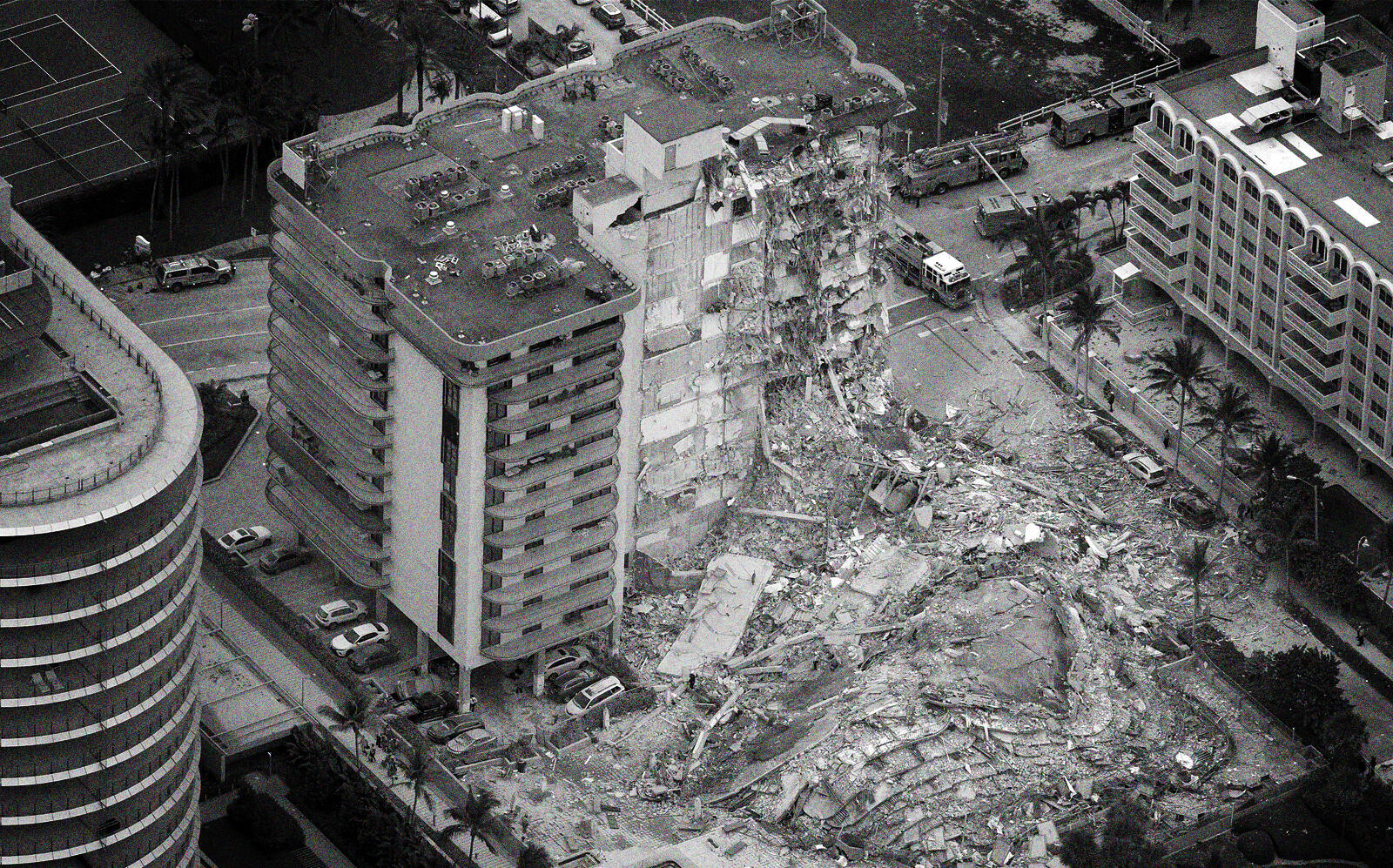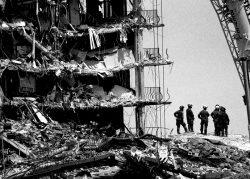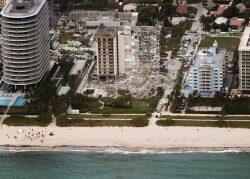 First lawsuit filed in deadly Surfside condo collapse
First lawsuit filed in deadly Surfside condo collapse
Trending
Inside the tug-of-war over the Surfside condo site’s future
Judge orders the site listed for sale, early offers top $100M

Steve Rosenthal loved living along the beach, chatting with his neighbors by his condominium’s pool, having everything he needed just a short walk or drive away. That was his life at Champlain Towers South in Surfside.
Rosenthal lost many of his friends when the majority of the 12-story condominium collapsed last month, killing at least 97 people. He was rescued from the part of the building that did not cave in, but which was later demolished. Now he is reluctant to even see what remains of the rubble.
The 72-year-old hopes a memorial will be created at the site. But he also wants to be made whole for the $500,000 he lost in his home of 20 years.
It’s a Catch-22 for many. On one hand, a memorial seems fitting in light of the tragedy. But it will not yield payouts to survivors like Rosenthal and families of victims.
Selling the property at market value for a new development will yield higher disbursements. But given how many died there, that could be considered morally questionable.
As the dark cloud from the calamity lingers over South Florida, the issue of what is to become of the site has divided victims, developers and the rest of the community.
Just as contentious is how much decision-making power victims will have over the site’s future.
“Many, especially those who have lost loved ones, have indicated to me for the site to become a memorial,” said Robert McKee, an attorney who until Tuesday represented some of the victims and had filed suit on behalf of a survivor. “But they have no control over that.”
Hijacking the decision
Instead, control seems to be in the hands of the court. Miami-Dade Circuit Judge Michael Hanzman, who is presiding over the deluge of lawsuits against the Champlain Towers South’s condo association, said he wants the property listed for sale — and soon.
The judge has said it is necessary to supplement the $48 million in Champlain insurance, which won’t be enough to compensate victims. The amount breaks down to $30 million for the physical building and $18 million in liability coverage.
Preliminary estimates put the oceanfront lot’s value at $110 million to $130 million, Michael Goldberg, the receiver overseeing the association’s financial matters, said in court. The sale price hinges on the future use, meaning the site will generate more money if the purchase is for development.
Read more
 First lawsuit filed in deadly Surfside condo collapse
First lawsuit filed in deadly Surfside condo collapse
 Emails, condo meeting minutes show Surfside official turned a blind eye to structural issues
Emails, condo meeting minutes show Surfside official turned a blind eye to structural issues
 Surfside collapse a “come to Jesus moment” for South Florida’s condo market
Surfside collapse a “come to Jesus moment” for South Florida’s condo market
The receiver’s job is to maximize payments to survivors and victims’ families, but he still could work toward a middle ground, said Joe Luzinski of consulting firm Development Specialists, who also serves as a receiver in other cases.
“You are not going to find the fine line,” he said. But the goal still is “to find a path through a difficult and complex situation, so that all parties hopefully feel they have gotten a fair representation of their interests.”
In Champlain’s case, some victims feel the decision will end up as whatever the receiver and judge think is right, McKee said. Some won’t file court claims. “They don’t want that money to be representative of their loved one’s life,” he said.
Goldberg, of Akerman, said in court he wants a stalking horse bidder to set the bottom price. He declined to comment to The Real Deal, including on what future use the preliminary estimate is based.
Surfside commissioner Eliana Salzhauer said it is not yet time to think about developing the site.
“It’s too soon for developers with a conscience. But a lot of developers don’t have one,” she said. “I think the minute they heard about this they thought, ‘Wow, there is a big piece of land available on the ocean, and I am going to make a lot of money on it.’”
New chapter or bad karma
Could she be right? The first few inquiries regarding buying the oceanfront site have come in at $100 million to $110 million, according to court records.

Art Falcone
The heads of five major South Florida developers — Falcone Group, Astor Companies, Estate Companies, Shoma Group and Peebles Corporation — told TRD they are not planning to bid on the site.
Some speculated that the region’s real estate behemoths — Related Group, Dezer Development and Terra — are the most likely contenders to build another condo project to replace Champlain Towers South. Related responded that it does not plan to bid on the property. Terra also is not interested in the site, according to a source familiar with the firm’s plans.
Dezer declined comment.
The developers who spoke with TRD were split on the lot’s future and what they would do.
“For us, it would not be positive karma to develop something there,” said Art Falcone, of Boca Raton-based Falcone Group and one of the master developers of Miami Worldcenter. “I just wouldn’t feel right about developing something where [97] people lost their lives.”
Henry Torres of Astor Companies said that if his Coral Gables firm was a builder of luxury oceanfront condos, he would definitely try to redevelop the site. But he is not “money hungry,” he said.

Henry Torres
The practical approach is to compensate those affected, help the town and county generate tax revenue, and move on, he said. A new building would be “like a new birth,” Torres said.
“If we can show any kind of gratitude to the ones who lost their lives, we would build another building, bigger and better and more beautiful,” he added.
Not everyone embraces Torres’ approach. Those who agreed that a building should rise on the site also called for a memorial on part of the property.
When Robert Suris’ Estate Companies in South Miami built the Soleste Twenty2 apartment complex, it included a memorial for a soldier who died in Afghanistan and lived in one of the houses on the West Miami lot. Similarly, a project with a memorial should be built in Surfside, Suris said.

Robert Suris
He echoed other developers who pointed to the 9/11 site in Manhattan, which combines a memorial with a rebuilt World Trade Center complex, as a guide for the Champlain site. The National September 11 Memorial & Museum was created at Ground Zero.
“Definitely they should keep that [Champlain site] as a memorial park. The same thing they did at 9/11,” said Masoud Shojaee of Coral Gables-based Shoma Group.
Shojaee shifted his position on whether he would build in Surfside, highlighting the difficulty of the decision. He eventually said that he would, only if victims’ families agree to a project, which he called “a big if.”
“The more you think about it, the more uncertain you are,” he said. “Too many things involved. Every time you go visit your job, it is going to be a reminder of the people who got killed.”
Hope for memorial
Those impacted by the Champlain collapse are not losing hope for the future of the site, as it still could be a memorial and generate disbursements at the same time, McKee, the former victims and survivors’ attorney.
Federal, state and local governments could work with a donor who steps up to bankroll the land purchase, he said.

Don Peebles
Real estate investor Don Peebles says the onus is on the government to buy the property for the highest value, which would be for a condo project, but then build a memorial.
“All around the country the government buys private land at fair market value for public purposes,” Peebles said.
Rosenthal, the collapse survivor, suggested that approach to President Joe Biden and Gov. Ron DeSantis when they met with survivors and victims’ families in the aftermath.
Yet so far, no sign has emerged of a donor or government plan.
That leaves Rosenthal, who is staying temporarily at the W South Beach hotel, anxious about how he will dig himself out of his financial hole. He has three realtors looking for a place for him and has had to take out “chunks” from his individual retirement account. His possessions consist of what he could fit in a shopping bag in the minutes before fleeing his unit.
“I am homeless,” he said, adding that at this point he is OK with a developer buying the site. “A memorial would be nice, but if some developer wants to come in and pay an exorbitant price, who am I to say, “Hey, don’t buy it.’ And maybe the developer could put some plaque” in memory of the victims.
“It was the best [place] in my opinion,” Rosenthal said of Champlain Towers South. “Now where am I going to find something like that?”




